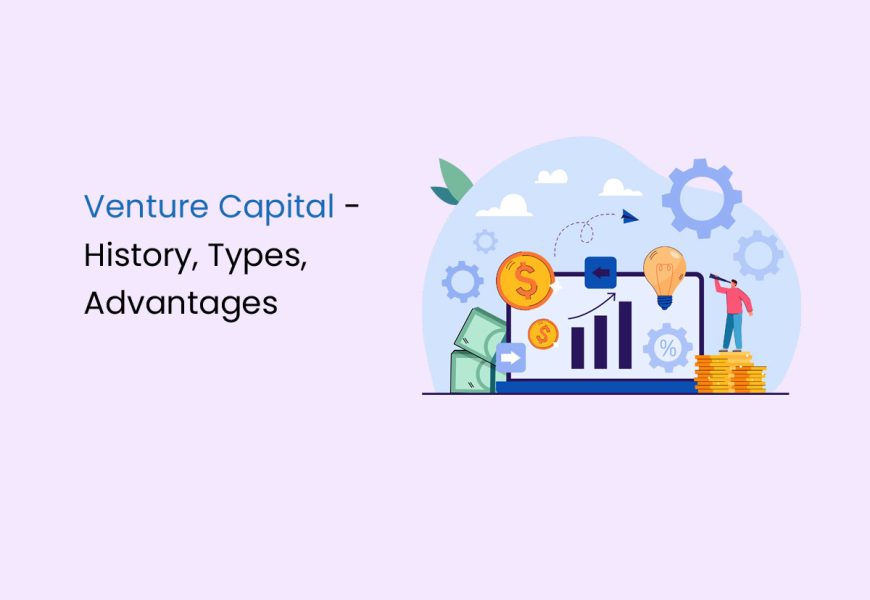The global economy is a dynamic space; innovation is a driving force that captures imagination worldwide. Entrepreneurs are often portrayed as modern trailblazers, with venture capital serving as strategic partners navigating challenges to secure a stake in this landscape.
However, the venture capital scene has evolved. No longer resembling cowboy adventures, today’s venture capitalists are more like bankers, supporting entrepreneurs with MBA credentials. This article will talk about venture capital, aiming to unravel truths and dispel myths. From Silicon Valley legends to present-day scenarios, understanding this landscape is vital for entrepreneurs and emerging business leaders. Read on to decipher the realities defining the contemporary global venture capital ecosystem.
What is a Venture Capital (VC)?
Venture capital (VC) represents a subset of private equity financing aimed at supporting startup companies and small businesses anticipated to have substantial long-term growth. Typically sourced from affluent investors, investment banks, and various financial institutions, venture capital is not solely confined to monetary contributions; it frequently manifests as valuable technical or managerial expertise. This form of financing is strategically directed towards small enterprises displaying exceptional growth potential or those already on a rapid expansion trajectory.
They provide financial backing for startups and small enterprises with high growth potential. This funding typically takes the form of private equity (PE) and may extend to valuable expertise, such as technical or managerial support.
VC transactions often involve the creation of substantial ownership shares in a company, which are then sold to a select group of investors through independent limited partnerships. These partnerships, established by venture capital firms, often comprise a pool of similar enterprises.
A key distinction between venture capital and other private equity transactions lies in their target companies. Venture capital primarily focuses on emerging companies seeking significant funding for the first time. In contrast, private equity tends to support larger, more established companies looking for an equity infusion or opportunities for company founders to transfer ownership stakes.
Despite the associated risks, venture capitalists are drawn by the potential for above-average returns. Particularly for new ventures with limited operating history—typically under two years—VC is becoming an increasingly vital source for raising funds, especially when access to capital markets, bank loans, or other debt instruments is limited. The trade-off, however, is that investors usually acquire equity in the company, entitling them to a say in significant company decisions.
Historical Roots of Venture Capitals
Venture capital, a subset of private equity, finds its roots in the latter part of the 20th century, notably post-World War II. The acknowledged “Father of Venture Capital,” Harvard Business School professor Georges Doriot, played a pivotal role in shaping this industry.
In 1946, Doriot founded the American Research and Development Corporation, a milestone in the emergence of venture capital as an industry. The professor raised a fund of $3.58 million dedicated to investing in companies that aimed to commercialise technologies developed during WWII.
The corporation’s inaugural investment was in a company exploring the use of x-ray technology for cancer treatment. Doriot’s $200,000 investment burgeoned into $1.8 million when the company went public in 1955. This transformative success marked a significant milestone in the history of venture capital, laying the groundwork for its subsequent growth and evolution.
Hit From the 2007-2008 Financial Crisis
The 2007-2008 financial crisis impacted the VC industry. Venture capitalists and other institutional investors, who were an important source of capital for many startups and small companies, tightened their purse strings.4
Things changed after the end of the Great Recession with the emergence of the unicorn. A unicorn is a private startup whose value is over $1 billion. These companies began attracting diverse investors seeking big returns in a low-interest-rate environment, including sovereign wealth funds (SWFs) and major PE firms. Their entry resulted in changes to the venture capital ecosystem.
Westward Expansion
Initially rooted in the Northeast and predominantly backed by banks, venture capital (VC) underwent a transformative shift towards the West Coast, particularly fueled by the burgeoning tech ecosystem. The trajectory of this shift is intricately linked to pivotal events.
Fairchild Semiconductor, often regarded as the inaugural tech company to receive VC funding, saw its genesis with funding from Sherman Fairchild of Fairchild Camera & Instrument Corp. This marked a crucial moment in VC history, symbolised by the emergence of the “traitorous eight” engineers from William Shockley’s Semiconductor Laboratory.
Arthur Rock, an investment banker at Hayden, Stone & Co. in New York City, played a key role in facilitating the Fairchild Semiconductor deal and went on to establish one of Silicon Valley’s pioneer VC firms, Davis & Rock. The firm contributed funding to influential technology giants like Intel and Apple.
By 1992, the West Coast commanded the lion’s share of VC investments, with 48% of total investment dollars directed to companies in the region, while the Northeast lagged behind at 20%.
Fast forward to 2022, and the West Coast’s dominance in the VC landscape endures, accounting for over 37% of all deals and approximately 48% of deal value. In contrast, the Mid-Atlantic region secured around 24% of all deals and roughly 18% of deal value.
The figures from 2022 reflect the continued prominence of the West Coast in the VC arena, showcasing its enduring influence and significance.
How Does Venture Capital (VC) Work?
Venture capital (VC) operates on a strategic trajectory, involving crucial elements that shape its functioning.
Investment and Exit Strategy
Entities engaged in VC invest in a company with the aim of securing a significant position and subsequently exiting the investment. In an optimal scenario, capital infusion occurs over a two-year period, followed by a five-year window for returns to materialise. Expected returns in this dynamic landscape can reach remarkable heights, potentially soaring to 10 times the initially invested capital.
Diverse Sources of Financial Venture Capital
Financial venture capital, a pivotal facet of VC, emanates from various sources, including:
- Investment banks and financial institutions
- High net-worth individuals (Angel investors)
- Venture capital firms
Role of Venture Capital Firms
Venture capital firms play a central role in the ecosystem. They orchestrate the creation of venture capital funds, constituting a pooled resource derived from investors, companies, or other funds. Notably, these firms often inject capital from their coffers, serving as a testament to their commitment and confidence in the ventures they support.
This intricate interplay of investments, diverse financial sources, and the instrumental role of venture capital firms collectively define the dynamics of venture capital, an influential force in fostering innovation and driving economic growth.
When to go to VC?
Venture capital funding is a pivotal decision, and selecting the right timing is crucial for maximising its benefits.
Expansion Phase
Venturing into the realm of venture capital funding is particularly advantageous during the expansion phase of your business. When gearing up for business expansion, the infusion of capital from venture capitalists not only provides financial support but also leverages their business acumen, financial insights, and legal expertise. This multifaceted support is often imperative when navigating the complexities associated with business growth.
Strong Mentoring Requirement
When the need for robust mentoring becomes apparent, venture capital funding emerges as a strategic choice. Beyond capital injection, venture capitalists bring a wealth of expertise, knowledge, and a well-established network. Utilising their guidance can enhance your networking capabilities, promote your business with strategic direction, and propel it towards greater heights.
Facing Competition
As a startup gains momentum and stands on the brink of facing intensified competition in the market, this juncture marks a fitting time to consider venture capital funding. The capital infusion, coupled with the expertise provided by venture capitalists, positions the business to survive and thrive in a competitive landscape.
Types of Venture Capitals
Venture capital funding plays a crucial role in supporting startups at various stages of their development. The types of venture capital funding can be categorised based on the ideation stage, the age of the startup, and its performance over the years. Here is an overview of the key categories:
| Funding Type | Objective | Amount Range |
|---|---|---|
| Pre-seed | Support R&D, Market Research, Recruit New Members | $100,000 – $200,000 |
| Seed | Develop a Viable Product for the Market | $1 million – $2 million |
| Series A | Scale Rapidly with a Market-Proven Product | $2 million – $15 million |
| Series B | Less Risky, Focus on Business Development, Advertising | $7 million – $20 million |
| Series C | Develop More Products, Services, Acquire Other Companies | $25 million (approx.) |
| Series D | Additional Expansion, Stay Private or Pre-IPO Expansion | Varied |
Advantages and Disadvantages of Venture Capital (VC)
Venture capital is a pivotal resource for burgeoning businesses, addressing financial gaps that often hinder early-stage operations. This dynamic relationship, fostering growth and innovation, brings forth a host of advantages and challenges, requiring entrepreneurs to navigate judiciously.
Pros
- Capital for Bootstrapping: VC serves as a critical source of capital, particularly beneficial for early-stage businesses grappling with the inaccessibility of stock markets and the challenges of securing traditional loans without substantial cash flow or assets.
- Holistic Support Beyond Capital: The significance of VC extends beyond monetary contributions. Investors often provide invaluable mentorship and networking services, assisting fledgling companies in establishing themselves, accessing industry expertise, and building crucial connections with talent and advisors.
- Catalyst for Additional Investments: A robust VC backing acts as a catalyst, enhancing the credibility of a venture and making subsequent funding rounds more achievable. This strategic support positions promising companies favourably for further investments.
Cons
- Equity Dynamics: In pursuing capital, entrepreneurs must grapple with the reality that VC investors typically seek a substantial share of company equity. While this infusion of funds is critical, it necessitates carefully evaluating potential dilution and its implications for ownership control.
- Navigating Loss of Creative Control: Accepting VC support may come with the trade-off of relinquishing some creative control. Investors may exert influence on strategic decisions, potentially leading to a delicate balance between the original vision and investor-driven priorities.
- Pressure for Expedited Returns: VCs, driven by the goal of rapid, high-return payoffs, may introduce tension by advocating for accelerated exits. This contrasts with a company’s desire for sustainable, long-term growth, prompting entrepreneurs to assess the timelines aligned with their vision carefully.
While VC funding opens doors to transformative growth, strategic decisions should align with the company’s broader vision. Delicate considerations surrounding equity, creative control, and growth timelines underscore the need for a thoughtful, informed approach, ensuring a harmonious integration of financial support with the preservation of core business values.
VC vs. Angel Investors
| Aspect | Venture Capital | Angel Investors |
|---|---|---|
| Provider of Funding | Provided by established venture capital firms and high net-worth individuals (HNWIs), commonly known as angel investors. | Sourced from individual angel investors who often have diverse backgrounds and entrepreneurial roots. |
| Investor Base | Comprises a mix of institutional venture capital firms and diverse HNWIs with accumulated wealth from various sources. | Encompasses self-made individuals, often former entrepreneurs or retired executives, contributing to a rich tapestry of experiences. |
| Investment Criteria | Requires well-managed companies with detailed business plans and poised for substantial growth. Alignment with the investor’s familiar industries is often a key criterion. | Looks for ventures aligned with an investor’s expertise, often within industries they are familiar with through professional or academic backgrounds. |
| Co-Investing Dynamics | Collaboration is common, with multiple venture capitalists or angel investors joining forces to fund a venture strategically. | Emphasises personal connections and it’s not uncommon for angel investors to co-fund ventures with trusted associates, pooling their collective knowledge. |
| Entrepreneurial Insight | While venture capitalists may bring industry expertise, they focus on strategic growth and returns on investment. | Many angel investors are entrepreneurs or retired executives, offering financial backing and valuable mentorship and guidance. |
| Strategic Considerations for Entrepreneurs | Entrepreneurs must align with venture capitalists based on industry expertise and growth potential. Co-investing dynamics bring collective wisdom to the table. | Entrepreneurs benefit from the diverse backgrounds of angel investors, who often provide hands-on guidance and personal connections. |
| Long-Term Vision | Venture capitalists often seek strategic exits for high returns, influencing the company’s trajectory. | Angel investors may have a more personal and patient approach, aligning with the long-term vision of the entrepreneur. |
Entrepreneurs must carefully weigh the distinctive characteristics of venture capital and angel investors. Each avenue offers unique opportunities, emphasising the need for alignment with the strategic imperatives of the venture.
Importance of VC
The Venture Capital industry in the United States is recognised as a catalyst for economic growth, with pioneers like Tom Perkins, Tommy Davis, Eugene Kleiner, and Arthur Rock playing pivotal roles in fostering the development of the modern computer industry. In the landscape of a capitalist economy, innovation and entrepreneurship serve as fundamental drivers. However, establishing new businesses is often fraught with high risks and substantial costs. Consequently, entrepreneurs frequently seek external capital to mitigate the risk of failure. In exchange for assuming this risk through financial investment, backers in emerging companies gain access to equity and voting rights at a fraction of the potential value.
In essence, Venture Capital is a crucial mechanism that empowers startups to initiate their ventures and allows founders to realise their visionary aspirations.
FAQs on Venture Capital (VC)
What is an example of venture capital investment?
Venture capital has fueled the growth of iconic companies like Hewlett-Packard, Microsoft, and Apple. VC firms invest in private companies with anticipated growth, gaining an equity stake in return.
What Percentage of a Company Do Venture Capitalists Take?
The ownership stake venture capitalists (VCs) acquire in a new company varies based on factors such as the company's stage, potential, investment amount, and the dynamics between investors and founders. Typically, VCs take between 25% and 50% of a new company's ownership.
What is the Difference Between Venture Capital and Private Equity?
Venture capital is a subset of private equity, which encompasses various investment approaches like leveraged buyouts, mezzanine financing, and private placements.
How does a VC differ from an Angel Investor?
Venture capitalists are professional investors who diversify their investments across a broad portfolio of startups. They offer hands-on guidance and leverage professional networks to support new firms. In contrast, angel investors, usually wealthy individuals, invest more as a personal interest or side project, providing less expert guidance. Angel investors often lead investments, followed by VCs.
How VCs Make Money?
Venture capitalists profit from carried interest on investments and management fees. Generally, VC firms receive around 20% of profits from the private equity fund, with the remainder going to limited partners. General partners may also collect an additional 2% fee.
Who Uses Venture Capital?
Venture capital (VC) is a type of financing that private investors provide to start-ups and small businesses with long-term growth potential.





















